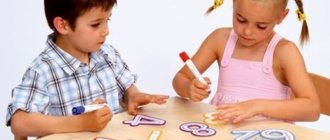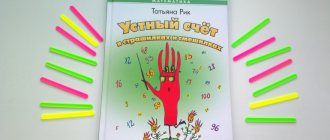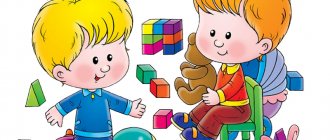The concept and essence of account and counting activities
Counting is an activity with finite sets. The account includes structural components:
goal (express the number of objects as a number), means of achievement (counting process, consisting of a series of actions reflecting the degree of mastery of the activity);
result (total number): it seems difficult for children to achieve a counting result, that is, a total, a generalization.
Developing the ability to answer the question “how much?” the words many, few, one two, the same, equally, more than speed up the process of children’s comprehension of the knowledge of the final number when counting. From the theory of arithmetic it is known that counting is the establishment of a one-to-one correspondence of elements between two sets being compared.
The main goal of doing mathematics is to give the child a sense of self-confidence, based on the fact that the world is orderly and therefore understandable, and therefore predictable for humans. The emergence of mathematical concepts occurred long before the appearance of mathematical texts themselves. The oldest mathematical activity was counting. An account was necessary to keep track of livestock and conduct trade. Some primitive tribes counted the number of objects by matching them with various parts of the body, mainly fingers and toes. A rock painting that has survived to this day from the Stone Age depicts the number 35 as a series of 35 finger sticks lined up in a row. The first significant advances in arithmetic were the conceptualization of number and the invention of the four basic operations: addition, subtraction, multiplication and division.
The first step or stage towards the emergence of counting was the establishment of a “one-to-one correspondence” between the objects being counted and some other set. The counting was based on one-to-one correspondences; “In some South African tribes, when counting, they touch each object in turn with their fingers, starting with the little finger of the left hand.” The most difficult stage that humanity went through in developing the concept of number is considered to be their separation of the concept of one from the concept of “many.” It happened, in all likelihood, even when humanity was at the lowest stage of development. V.V. Bobynin explains this selection by the fact that a person usually grabs one object with his hand, and this, in his opinion, distinguishes one from the many. Thus, the beginning of notation, according to Bobynin, is the creation of a system consisting of two representations: “unit” and “indefinite set”.
At the present stage, counting is the leading step in human education. From early childhood, a person strives to teach counting skills, which are used and improved throughout his life. The beginning of the development of numeracy skills is preschool mathematics education.
The founders of the system of mathematical education for preschoolers Ya.A. Komenskyi I.G. Pestalozzi believed that the foundations of arithmetic can be laid already in the third year of life, when children begin to count to five, and subsequently to ten, or at least begin to clearly pronounce these numbers. If in the fourth, fifth, sixth year they learn to count in order to twenty and quickly distinguish that 7 is more than 5, 15 is less than 30, then this will be enough.
In the pedagogical writings of the father of Russian didactics, K. D. Ushinsky, it is said that, first of all, children should be taught to count to ten on visual objects: on fingers, nuts, etc., which it would not be a shame to break if you have to show visually half, third, etc.
Features of the formation of ideas about number and counting in preschool children
In the course of mastering counting, children have difficulties in coordinating numerals with nouns in gender, number, and case (during the counting process, when summing up). These mistakes are natural. Their correction is facilitated by the teacher’s use of such techniques as explanation, correct selection of visual material, constant variation of it in the same lesson, attention and control of children’s counting activities. In case of an error, it is useful to invite the child to name one of the listed objects and choose the right word; one, one or one, and also think about how he would say about two objects: two or two.
By the age of six, children usually have developed counting skills. When practicing counting, preschoolers should understand that the result is influenced by any inaccuracies and errors. That is why we must strive not to miss an object and not to count one object several times, remember with which object the recount began, and coordinate numeral words with nouns when recounting.
Children learn the sequence in naming numerals, quite accurately correlate the numeral with each object of the group (element of the set), and learn the meaning of the final number. In the process of further education, work continues to develop counting skills.
As a result of the development of counting activity, children begin to understand the quantitative meaning of a number (a number serves as an indicator of quantity) and realize that it does not depend on the spatial and qualitative features of a set (groups of objects).
Sometimes it happens that if a child is often read the same book, he remembers it so well that he retells it by heart, turning the pages in the right place. From the outside it may seem that he can read. But once you give him an unfamiliar text, it’s clear that this is not the case. A similar story can happen with the account. The only difference is that an adult does not always clearly understand the difference between conscious counting and unconscious counting. This happens because some things that are obvious to an adult are sometimes a mystery to a child.
Thus, the studies of the famous psychologist J. Piaget (later these studies were called “Piaget’s sign”) showed that young children do not understand that the amount of water will be the same in a narrow glass, where the water level rises high, and in a wide glass, where the water level rises low They do not understand this even when water is poured in their presence, and they see that its quantity has neither decreased nor increased. Moreover, if several objects of the same shape are laid out in front of him, and then these objects are moved apart so that they occupy a larger area, while asking the question whether there are more, fewer or the same number of objects, he will claim that their number has increased. Some children, having memorized ordinal counting, do not know how to count correctly, that is, assign one object in sequence to each number. Difficulties also arise if you need to continue counting from a given quantity. All these difficulties indicate a still unformed concept of number that needs to be worked on. Otherwise, it may not be formed even in the first grade, which will significantly slow down the process of mastering the subject of mathematics.
Psychological and pedagogical foundations of the development of children of middle preschool age
Middle age is the most important period in the development of a preschooler.
The physical capabilities of children have increased: their movements have become much more confident and varied. In the middle group, it is especially important to establish a reasonable motor mode. The middle preschooler needs meaningful contacts with peers. Children communicate about toys, joint games, and common affairs. Their verbal contacts become longer and more active. Children easily unite into small subgroups based on common interests and mutual liking.
The main activity of middle-aged children is play, and productive activities also appear: drawing, modeling, designing. In story games, children easily use various substitute objects (for example, a cube as soap). This develops the child's fantasy and imagination.
In play, the child discovers for the first time the relationships that exist between people; the child himself can fulfill one or another role. The child’s mental activity develops in play. Within the play activity, educational activity also begins to take shape, which later becomes the leading activity. A preschooler begins to learn by playing - he treats learning as a kind of role-playing game with certain rules.
In the middle group, preference is given to the play structure of the entire lifestyle of children. Children participate in a variety of games throughout the day.
All types of classes either take the form of a game or contain game situations and actions. New features appear in the communication of middle preschoolers with the teacher. Children strive for cognitive, intellectual communication with adults. This is manifested in numerous questions from children to the teacher: “Why?”, “Why?”, “For what?”.
Children’s ability to establish the simplest connections and relationships between objects awakens interest in the world around them. The teacher’s friendly, interested attitude towards children’s questions and problems, the willingness to discuss them “as equals” with children helps, on the one hand, to support and direct children’s cognitive activity in the right direction, on the other hand, it strengthens the trust of preschoolers in adults. This promotes a sense of respect for elders.
A preschooler in his fifth year of life is highly active. This creates new opportunities for the development of independence in all areas of his life. There is an awakening of interest in the rules of behavior. The main thing is to anticipate the actions of children and orient them in advance to the correct behavior.
Middle-aged children are highly emotional and express their feelings clearly and directly. The teacher awakens the emotional responsiveness of children, directs it towards sympathy with peers and basic mutual assistance.
Children's aesthetic senses develop. They notice the beauty of nature, the sound of music. An adult helps the child with this. An attentive, caring attitude towards children, the ability to support their cognitive activity and develop independence, and the organization of various activities form the basis for the proper upbringing and full development of children in the middle group of kindergarten.
The teacher gradually develops the gaming experience of each child, helps to discover new opportunities for playful reflection of the world, awakens interest in creative manifestations in play and playful communication with peers.
A preschool child does not have sufficient abilities to connect temporal, spatial and causal sequences with each other and include them in a broader system of relationships. He reflects reality at the level of ideas, and these connections are acquired by him as a result of direct perception of things and activities with them.
When classifying, objects or phenomena are combined based on common characteristics into a class or group, for example: all people who know how to drive a car, etc. Classification forces children to think about the underlying similarities and differences between different things as they need to make inferences about them.
The most common methods of teaching children to count
To begin with, we note that counting on fingers has been and continues to be considered one of the most common techniques at all times. It is considered a classic, but, of course, is becoming outdated.
Counting sticks also belong to this category. Using special sets with such sticks, mothers and fathers begin to give their children simple tasks, such as, for example, putting one, two or three sticks in front of them, removing four sticks, etc.
However, such methods, according to the authors of more modern developments, may be able to explain in an accessible form what one, two and three are, but are completely unsuitable for memorizing numbers and solutions. In addition, the child will subsequently count very slowly. Alternative and more modern options help replace these “ineffective” methods.
The following deserve special attention (due to their wide distribution and popularity):
- Nikolai Zaitsev's method, which uses cubes of various colors, weights and sizes, as well as tables and cells corresponding to these cubes
- Glen Doman's method using dot cards
- Sergei Polyakov’s method, which uses multi-colored cubes (interestingly, these cubes can be glued together from colored paper and then filled with cereal)
We will talk in detail about the methods of Zaitsev and Doman (as well as some others) and their advantages and disadvantages in the third lesson, and now, taking into account the simplicity and possibility of independently preparing didactic material, we will analyze the Polyakov method in more detail.





